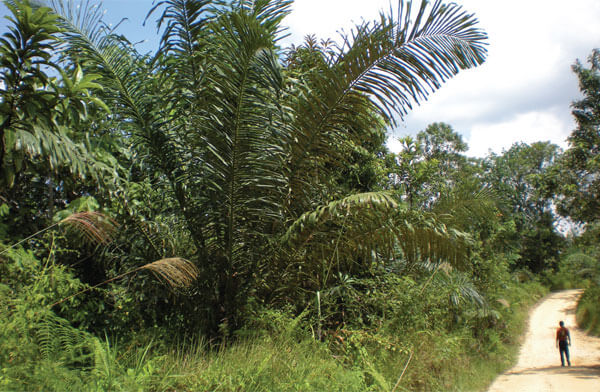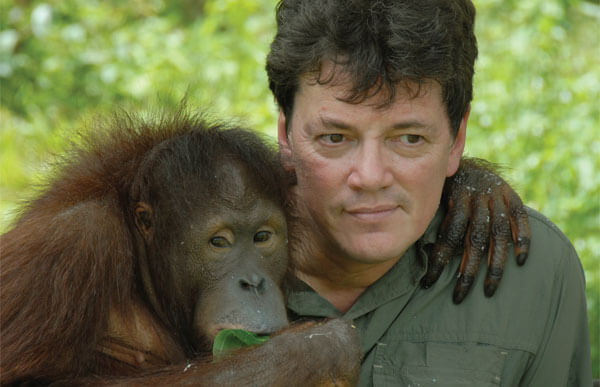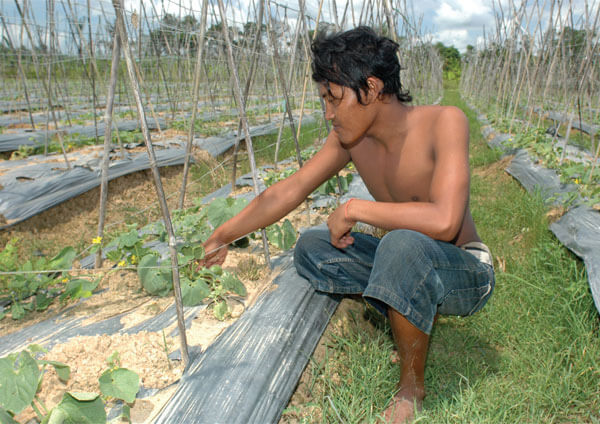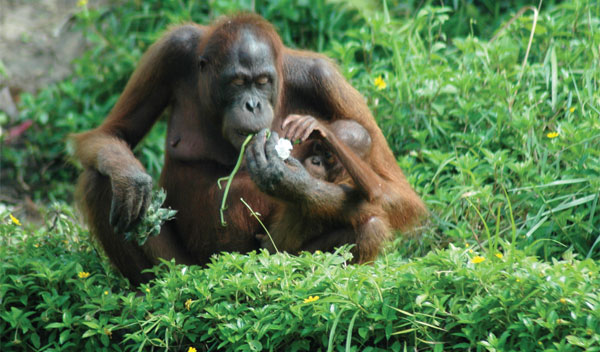Borneo experiment shows how saving the apes could save ourselves
Shawn ThompsonWebsite
A reforestation scheme in Borneo could radically reshape wildlife protection, land conservation, and indigenous stewardship—simultaneously.

Sugar palms are one of the crops that make up the plantation. Photo by Shawn Thompson.
Halfway around the world, on the eastern side of the island of Borneo, near the oil city of Balikpapan, a new tropical rainforest is being created out of what was once a poisonous wasteland. It is a story of radical loss and recovery for an entire ecosystem in a relatively short time. Only a century ago the rainforest was disparaged as “jungle,” wild and ripe for exploitation by the willing and the unscrupulous, its vitality apparently endless and unassailable. As part of that, in Borneo, near a town called Samboja, the land was ravaged by a lethal succession of mining, logging, slash-andburn farming, drought, and fires. Trees were cut down or burned. Alang-alang grass took root and secreted cyanide into the earth. The birds and animals disappeared. The sky was empty, dry. People could no longer make a living from the land. There was malnutrition. The life expectancy plummeted. Crime spread.
It was a heartbreaking downward spiral. As in Africa, South America, and Asia, Borneo’s once lush tropical rainforest was shrinking rapidly, pulling an entire ecosystem down with it, including one of the planet’s four species of great apes, the orangutan, now threatened with extinction. The process of devastation at Samboja started with the discovery of crude oil a century earlier but accelerated as the logging industry moved in, chewing its way through the forest to plunder its bounty. Nothing was left but barren fields of grass—the perfect fuel for the wildfires that snuffed out what remained of the land in the 1980s, when an El Niño–induced drought swept across the island. Blackened stumps still stand as symbols of the conflagration.
It seemed hopeless at Samboja—but, today, a controversial initiative is attempting to reverse the ecological collapse that has destroyed the forest. The project is the brainchild of a Dutch scientist named Willie Smits, a forester, microbiologist, and founder of the world’s largest agency for the protection of orangutans, the Borneo Orangutan Survival Foundation. Smits has a deep reverence for orangutans and so he launched this US$10-million project at Samboja designed to save the orangutans by saving Samboja’s rainforest. Smits, in his typically grand and ambitious way, is creating a model for a new kind of rainforest, one where people and wildlife can live harmoniously in an almost utopian symbiosis. Here, human beings, plants, and wildlife will exist together in a forest that sustains them both but preserves the fragile peace between humans and apes with a thorny barrier of salak palm trees. The orangutans get a home and food; the people regenerate the land that earns them a living.
The key to Smits’ vision is that human beings will have reason to protect the rainforest instead of just exploiting it. The new forest at Samboja could be an example to the world of a bulwark against the destruction of a species and, even more, the prototype for creating an entire ecosystem. Smits has such high hopes the project will endure that he named it Samboja Lestari—or “Samboja Forever.”

Dutch scientist Willie Smits with one of the Samboja orangutans. Photo by Cees Bosveld.
Eternity aside, there are more immediate concerns. Smits wants to preserve the diversity of a part of the natural world under severe stress—according to a 2007 Greenpeace report, Indonesia, which encompasses most of Borneo, has the highest rate of deforestation in the world. Smits believes his ambitious scheme can do a better job of sustaining both the local population and the local wildlife than traditional conservation methods. And yet Smits’ scheme is contentious and the science uncertain. His defiance of official and conventional thinking has created opposition—even within his own foundation. “The model I have developed is truly a model that can be modified for worldwide application,” Smits insists. “We can implement the techniques of Samboja in any place in the world. It is a recipe that is replicable.” If Smits’ project succeeds, it will be a miraculous accomplishment and a new symbol in a world where hope seems to be rapidly fading to reverse largescale environmental crises. But the big question still to be answered is whether Smits’ new ecological model is the best solution to deforestation—or just an expensive mirage.
The 53-year-old Smits is no idle dreamer, judging by the remarkable results so far at Samboja. I was there in 2004 while interviewing him for a book I was writing about orangutans and spent a week with him. It seemed that he was beyond ordinary things like food and sleep. Last summer, I went back to see the progress at Samboja Lestari.

Nature had returned. The hills that were once bare were flooded with trees. Where before there was nothing but grass and dirt across the project’s 1,850 hectares, frilly sugar palms had shot up alongside a diverse array of other tree species. Orangutans roamed on small islands and the distance between human and ape seemed to vanish for an instant. A mother orangutan was feeding a small child. A male gave me a bold look—and then quickly lost interest. A young orangutan was hauling himself through the leafy canopy on a rope. Officials from the project took me in a battered jeep to bounce along rutted and muddy roads to see the forest’s outer edge, where there are five villages with a total population of more than 10,000 people, some of them working to supply fruit and vegetables for the orphaned orangutans at Smit’s rehabilitation centre. Nanang Qasim, one of the project managers, told me the project tries to hire local people, rather than those from Balikpapan. It is the beginning of re-integrating a damaged natural community.
I talked to Muhammad Trafakhur Rochim, the Indonesian co-ordinator of human development for the project, who trains farmers from the villages. “They have a commitment to protect the land,” he said. “They really understand that this project is really important.” He said the contract to supply food for the orangutans is worth 125 million Indonesian rupiah a month (about $14,000) for a total of 150 people, and estimated the average monthly income for a worker in the villages is between one and two million rupiah.
I saw one truck come in loaded with melons for the orangutans and, in true Indonesian fashion, it stopped at a house just outside the preserve for a boy to pick a melon for his family, a gift from the red apes. The food was bound for orangutans confiscated by officials after they had been held captive illegally in homes, sometimes as though they were members of the family, at other times chained or held in cramped cages. The orangutans are quarantined and those who are not too sick to be released are rehabilitated for the forests. Those forests, however, have been reduced by logging. One of the three vets at the project, Dr. Siswiyani—with the single name that many Indonesians have—told me: “It’s difficult to find a release site for them because there is so much deforestation.” As we talked, a male orangutan named Sipur wandered nearby. “I love them all,” she said, echoing the kind of comment I heard so often from people who work with orangutans. “They are like humans, so I feel close to them.”
It is a critical time for a project like this, considering the endangered status of orangutans. Orangutans are only found in the wild in Borneo and Sumatra and most of that land is under the control of Indonesia. There are an estimated 60,000 orangutans left in the world, a number that is dangerously low and shrinking: close to 90 percent of the wild population was lost in the 20th century alone. The rainforests of Indonesia are decimated for palm oil plantations, which support consumer products such as cooking oil, biofuel, chocolate, ice cream, margarine, toothpaste, soap, cereal, and cosmetics. “There is not a single protected area in Indonesia that is not under threat,” says Smits. He believes his project can eventually support 2,000 people and 1,000 orangutans, the number of orangutans that many scientists think can create a self-sustaining population without inbreeding.

Melons are grown by local farmers to feed the orangutans. Photo by Shawn Thompson.
It is a task of incredible complexity (some would say scientific hubris) to recreate the diverse ecology of a tropical rain forest. And yet Smits seems to be accomplishing just that. The reconstruction of the ecosystem, as he explains it, needs nutrients and microorganisms that live in symbiosis with the roots, and it needs the right combination of the right trees, everything staged in the right sequence. The compost for the transformation—an elixir of life —comes from a recipe that Smits concocted to combat the hard, infertile soil. He mixed alang-alang grass, rotten wood, sawdust, rice husk, leaves, peels, and remains of fruits and manure from cattle and chickens with a microbiological agent he made from sugar and cow urine. Chalk and nitrogen were added to speed up the process, which takes less than three weeks to complete. Smits says the trees that were planted have created a microclimate that has lowered the average temperature in the forest by between 3 and 5C, increased cloud cover by approximately 12 percent, and improved rainfall by 20 percent. The project has small lakes and reservoirs, an eco-lodge, a sun-bear sanctuary, and a research centre where individual trees are monitored by satellite imaging. There are now over 1,200 species of trees, 137 species of birds, and nine species of primates at Samboja Lestari.
With all the changes, according to Smits, the health, contentment, and economy of the community have improved dramatically. A community of 2,000 Indonesians is being established through the local farmers, who are offered free land for agreeing to live harmoniously with the wildlife and to support the ecology of the forest. The farmers plant crops of pineapples, papayas, beans, and corn, and that list will be expanded to include bananas, cacao, and chilies. The farmers can harvest the sugar palms, which may someday be sold to the sugar refinery that the Borneo Orangutan Survival Foundation wants to build, and can also produce the material for ethanol to run a generating station. Smits wants to build schools for the farm community that will teach humanitarian principles and ecological practices.

He says that unless they build a forest that supports the local economy, the onslaught of logging will continue. So this new forest is designed to be protected by the people who make a living from it. “If you want to help orangutans, make sure the local people benefit,” he insists. “This forest can do so many small things that make the total sum much more.”
Not everybody is convinced by what Smits says. They have questions. They want details. They want to know why so many resources should be put into creating new forests, when efforts could go toward saving the existing ones. Erik Meijaard is one of those asking pointed questions. A conservation scientist with a background in biological anthropology, Meijaard has been working in
Indonesia for the past 18 years, including a stint in the 1990s under Smits. Meijaard says it remains unclear whether Samboja Lestari is a good idea that achieves results, and that the success will ultimately depend on the extent to which it can improve community livelihoods and achieve long-term financial stability. “That question remains unanswered,” he notes, “and will remain so for a few years, because that is the kind of time such projects need to be evaluated.” Meijaard raises other questions about the enormous cost of projects like Samboja, and their financial sustainability, too. He, like others, says that it is better to concentrate on projects that attempt to protect the remaining forests instead of trying to create new ones from scratch.
“Overall this is a good project with some real potential benefits for people, nature, and climate,” he says.
“But the question is how cost-effective and sustainable is it compared to other approaches.” Meijaard says that during his time with The Nature Conservancy, Indonesia had agreed to protect two limited forests, of 38,000 and 11,000 hectares respectively, holding between 500 and 750 wild orangutans. That is as safe as it gets in Indonesia, says Meijaard. He adds: “This is not a competition between two projects, but it does raise the question whether the far higher costs of Samboja Lestari justify its relatively limited benefits.”
According to Meijaard, the Samboja Lestari project is a reaction to the intensive illegal logging on the release sites where Smits’ organization had sent rehabilitated orphan orangutans—but without a clear indication of how many orangutans survived those circumstances. “So, the idea was to rebuild a forest from scratch, get local tenure issues sorted out from the start, deal with community conflict before it arises, and eventually have a safe haven for orangutans. But how many orangutans could the area harbour?” Despite Smits’ infectious optimism, Meijaard points out that the normal population of wild orangutans that a forest can support is much lower than the number planned for Samboja Lestari. “Can the forest provide enough resources for such high densities, or will it be more of a semi-wild population that relies on additional feeding and cannot be allowed to breed? And where would the population expand to?”
Smits thinks the obstacles can be overcome, that Samboja Lestari could hold 50 times more fruit trees than a natural forest, and support a near-miraculous 1,000 orangutans in a space where a conventional forest could normally support only 60. And yet even Smits is worried about how precarious the project is. “So far,” he says, “it is an experiment and I fear it can still go wrong.”

A mother and child at the Samboja Lestari orangutan preserve. Photo by Shawn Thompson.
There is a deeper meaning to the venture at Samboja Lestari. It is a critical time for rainforests and the life that depends on them, including ours, and Smits’ rainforest could encourage a pivotal shift in our thinking. If the idea of Samboja overcomes all the political and economic obstacles and proves to be workable, it could be part of a momentous change in our relationship with the natural world. The broad history of our interaction with the rainforest has been defined by our denigration of its strength and beauty. We have misunderstood it, reviled it, misused it. Now Smits wants to take a big leap forward with a radical recreation of a forest designed for human beings and wildlife alike.
Smits has seen what happens if we don’t dare to think big and act boldly. He told me about the dramatic effect the huge fires that swept across Kalimantan had on his thinking. They were the catalyst for Samboja Lestari. “We were busy trying to save as much forest as possible. One night we went to save my research plot from fire and drilled a water hole. When the first muddy water came out we were overrun by at least 10 wild boars that bumped us over and started to drink the muddy stream. There was a deer standing still and I could touch it and noticed its legs had burned. Then she fell.” The deer died soon after. “An owl sitting on a branch fell dead. Those pictures of what happens in those forests that are drying out—a process that is worsening with climate change—are some of the most dramatic images I still carry with me.” Smits says it is images like these that make him attempt the near-impossible. “In Samboja Lestari, when I stood on that barren hill in the afternoon, I was watching the most extreme consequences of those fires and forest destruction—the vastness of yellow grass, just grass eerily silent. Not even insects! I wanted to see a damp forest again and hear the voices of birds.”